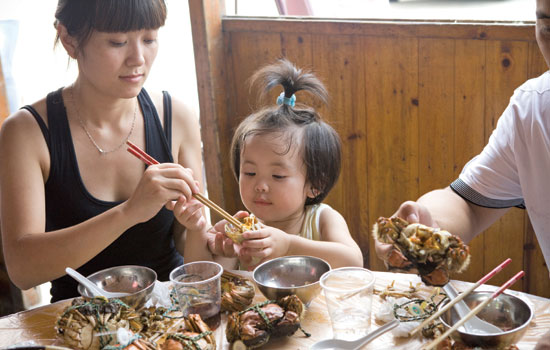
Businessmen consider importing unwelcome, invasive clawed delicacy
Reports of Chinese mitten crabs invading rivers in Germany and Great Britain are prompting calls for them to be imported into China as a seasonal delicacy.
|
 |
|
Chinese, not only adults but also children, regard hairy crabs as a top delicacy in Shanghai cuisine. However, compared with China's extravagant prices, the price for mitten crabs in Europe is less than 100 yuan ($15.75) a kilogram. Some businessmen are now considering the possibility of importing the species into China from countries where they are not wanted. [Photo/China Daily] |
Last month, UK and German newspapers cited alarm being expressed by the growing numbers of the alien species because of their tendency to riddle fragile river banks with holes, causing them to collapse and threatening the habitats of other creatures. It is believed they arrived in Europe via the holds of ships that draw in water to act as ballast.
UK's Environment Agency said the number of the Chinese mitten crabs has been increasing: "There are no official statistics on the crabs but from Woolwich to Windsor, they number tens of thousands," it said in a statement.
Related reading: Falsely labeled crabs upset the market
Britain's Natural History Museum said: "In the right conditions, the mitten crab multiplies and spreads at an astonishing rate. The crab can even leave the water, cross dry land and enter a new river system. Its phenomenal ability to disperse is of concern to scientists in the UK because the crab could infiltrate many of the country's rivers."
It is not only the UK that is suffering the unwelcome invading species; the Rhine in Germany also has its fair share of the crustaceans.
"It's unbelievable Chinese crabs are emigrating to Europe and no one there likes it. I hope I can go and enjoy the tasty and pollution-free European mitten crabs," an Internet user named Tutu said.
Tutu is not the only one who expressed an eagerness on the Internet to sample the delicacy after many Chinese cuisine lovers heard about the creature's population explosion in Europe.
The crab, named for its bristly claws which resemble mittens, was first discovered in the Thames in London in 1935, but it is only since the early 90s that their numbers have started to run out of control.
The Chinese mitten crab is native to eastern Asia. In Europe it was first found in Germany in the early 1900s and has since expanded throughout a number of waterways in northern and central Europe.
Related reading: Crabs in buckets, business on budget
In the United States a Chinese mitten crab was first discovered in South San Francisco Bay in 1993. Since then, a well-established population has become established throughout the entire San Francisco Bay estuary system.
Rather than seeing them as a threat to the local ecological system, the Chinese treat the hairy crabs as a top delicacy in Shanghai cuisine.
The most famous mitten crabs on a Shanghai menu come from Yangcheng Lake in Suzhou, in East China's Jiangsu province.
For the Mid-Autumn Festival, crab is a special delicacy and eating them is a tradition handed down from royal families in ancient China. They are steamed or fried and eaten with vinegar and sliced ginger.
Due to rising demand for the Mid-Autumn Festival delicacy, production has been increasing. At present, annual production of hairy crabs in Yangcheng Lake is around 2,200 tons, but that is insufficient to meet the surging year-after-year demand, which has pushed up prices.
In September, prices for Yangcheng Lake crabs at supermarkets and stores in Beijing reached more than 500 yuan ($78.74) a kilogram. Local salesmen said they will remain expensive for the next three to four weeks.
Compared with China's extravagant prices, the price for mitten crabs in Europe is less than 100 yuan a kilo. Some businessmen are now considering the possibility of importing the species into China.
Overseas newspapers have been reporting the number of the "pests" could be controlled or reduced in Europe by selling them to China. That would enable the Chinese to enjoy the delicacy at a lower price and, maybe, boasting higher quality.
"The most difficult part in importing crabs from Europe is getting certification for imports and animal quarantine from the Chinese government. Usually it will take more than a year," said an industry expert who would only be identified as Huang from the Beijing Institute of Aquatic Sciences.
Liu Xuping, from the Shengtong Export and Import Trade Co, said: "Even after getting the certification there are still complicated procedures to undergo in catching the crabs, quarantine and inspection in Europe, as well as the need for a lot of different permissions from customs and the animal quarantine and inspection bureau on the Chinese side."
Liu said there are a small number of Chinese companies with the relevant certification to import live aquatic products, adding: "Although the number is tiny, I heard some are conducting trials."
The London Port Health Authority, the food authority for the Thames, said it needed to conduct a study to discover whether the crabs from there are safe to export and eat.
liwoke@chinadaily.com.cn
 Audi: Local models, not price cuts, hold the key
Audi: Local models, not price cuts, hold the key Toyota to recall 1.4m cars in China
Toyota to recall 1.4m cars in China Overseas energy projects get green light
Overseas energy projects get green light Use of RMB as settlement currency rise
Use of RMB as settlement currency rise